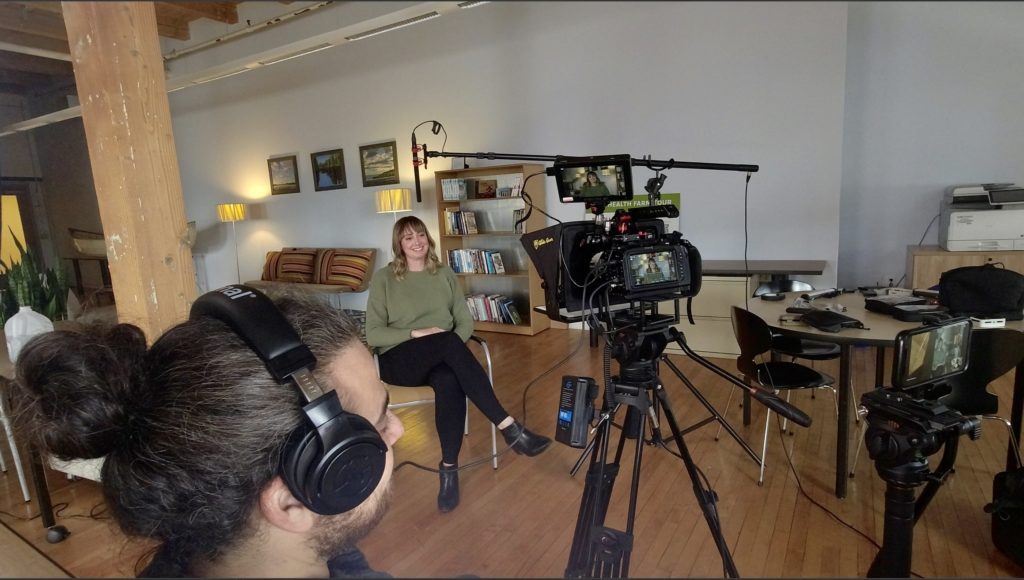Given the packed room, $15K budget, and months of planning for what she hoped would excel her nonprofit video engagement, Luna had high hopes. But three minutes into the video premiere, the audience at the gala was scanning their phones. By the end, a major donor leaned over and said, "It looked nice…but what was it about again?" Luna's face reddens.
These days, nonprofit videos don't fail because they look bad. They fail because they say everything and end up saying nothing. If you want to improve your nonprofit video engagement, it starts by avoiding this painful mistake.
Table of Contents
- Cramming Your Entire Story in One Video Hurts Video Engagement
- Why Does Cramming Keep Happening
- Sharing Facts Isn’t the Same as Telling a Story
- How to Improve Nonprofit Video Engagement Without Overloading Your Story
- Bonus Tip for Better Video Engagement: Build a Story Infrastructure
- Singular Focused Stories Drive Stronger Nonprofit Video Engagement
- Explore Holistic Storytelling
Cramming Your Entire Story in One Video Hurts Video Engagement
Imagine a video opening with a drone shot of lush farmland. Then a partner speaks, then another, and then another. Each interview features intros, jargon, and generic statements about food insecurity. It sounds informed, but not moving.
Luna and her nonprofit wanted to show how regenerative farming transforms the local food system. But the video ended up crammed with talking heads and missing a clear storyline. Additionally, the video team didn’t exclude much. After all, they spent several full days recording interviews. So, the final cut looked polished, but it felt like someone reading an ingredient label aloud.
These “videos” are like a vacationer cramming clothes into one carry-on to avoid another bag. Here’s what goes in:
- The mission
- The origin story
- The programs
- The numbers
- The board chair
- The intern’s dog (okay, maybe not the dog)
Yet, without an intense emotional experience, it’s not a story. Without a story, you have a compilation of thoughts, a mashup of great soundbites that don’t go deep.
Why Does Cramming Keep Happening
Since 2013, I’ve watched this play out repeatedly. I’ve made these mistakes at the beginning of my career. It usually happens when organizations:
- Have a limited budget for storytelling.
- Fear of leaving out key details.
- Need to please multiple internal stakeholders.
- Don’t fully understand what makes a story work.
- Think that more information means more clarity.
The result? You get bloated content that looks good but fails to drive real video engagement.
If you're like Luna, you received some funding to "tell your story." Then you hired a different Videographer instead of a Storyteller to make the ultimate organizational video. What started as a 3-minute deliverable ballooned to 8 minutes. Why? Everyone wanted in:
- The ED: “Feature all three of the seven programs.”
- Dev Team: “Donor recognition, please.”
- Board: “Show us volunteering!”
- Scientists: “Explain the research.”
- Education Team: “Highlight our curriculum.”
Before the Luna's gala, she watched the good-looking final cut and even caught herself checking her watch. She knew something was off, but couldn't articulate it. Six months later, the $15K video sits buried on their site. The average total watch time is 3:47.
Sharing Facts Isn’t the Same as Telling a Story

Earlier in my career, I let clients cram in facts to feel "safe." I’d nod along, hoping the footage said enough to avoid leaving something important out. I believed that more facts = more clarity. However, that mindset destroys emotional engagement.
Fact sharing is only information sharing. Storytelling embodies both information and is wrapped in one’s significant emotional experience. Facts and stats don’t convey experience or how someone felt. Studies from cognitive scientists like Tali Sharot show that emotional events are often remembered with a greater sense of vividness and confidence (recollection) compared to neutral events.
Even today, I must remind myself and our team that real stories don’t come from summaries. They come from emotional experiences. Understanding the difference between storytelling and fact-sharing is essential to improve nonprofit video engagement and move people emotionally.
How to Improve Nonprofit Video Engagement Without Overloading Your Story
Considering everything I’ve discussed so far, here’s how to apply this insight practically:
- Start with one story thread. Focus on one person, conflict, and outcome.
- Cut the clutter. Remove personal intros and partner mentions, unless they move the story forward.
- Ask better questions. Use questions rooted in experience and transformation to draw out emotion.
- Edit with emotion. Place emotional quotes early, not after the drop-off.
- Build a story roadmap. Plan your stories over time, not in one overloaded video.
Bonus Tip for Better Video Engagement: Build a Story Infrastructure
Another cheat code for avoiding overloading a single video is to build a story infrastructure or system that aligns with specific goals. A story infrastructure consists of creating a content strategy to help you determine how each story builds into your larger narrative.
A while back, we implemented our Holistically Organizational Storytelling practice to build a storytelling strategy for an environmental organization. Sadly, they didn’t use it, but the infrastructure is worth sharing. We mapped stories to their strategic plan:
| Desired Outcomes | Story Type(s) |
| Boost Partnership Growth | Environmental Justice Award winners—ongoing stories, not one-offs |
| Strengthen Organizational Culture | "Values in Action" stories that show principles in practice |
| Increase Regional Impact | Hyper-local project stories in each of the four regions |
| Leadership Development | "Lessons We’ve Learned" series featuring staff insights |
The outcome? Not one flashy video. A video library of focused stories, released over time, to grow engagement and recall. Your video story library is the outflow of your content strategy. Your content strategy is the outflow of your strategic plan. This 3 phrase approach is foundation to holistic storytelling.
Singular Focused Stories Drive Stronger Nonprofit Video Engagement
Start by telling less if you want your next video to hit harder. Your audience doesn’t need everything, nor do they need everything spelled out for them; they’re smart. They need one story told well. Focus on one main person, one conflict, and one outcome. That alone will shift how your audience connects and engages with your content. And once you have a holistic storytelling practice, you won’t feel pressure to word vomit in. You’ll know: another story is coming. That’s how trust is built, affinity grows, and nonprofit video engagement becomes a natural outcome of your story strategy.
Explore Holistic Storytelling
If this article resonated with you, explore how Holistic Storytelling can help you build trust, deepen connection, and roll out stories with purpose.
Related Articles
References
- Sharot, T., & Yonelinas, A. P. (2008). Differential time-dependent effects of emotion on recollective experience and memory for contextual information. Cognition
- Hirst, W., & Phelps, E. A. (2016). Flashbulb Memories. Current Directions in Psychological Science
- Talarico, J. M., & Rubin, D. C. (2003). Confidence, not consistency, characterizes flashbulb memories. Psychological Science
- Oaks, T. (1995). Storytelling: A Natural Mnemonic: A Study of a Storytelling Method to Positively Influence Student Recall of Instruction. Doctoral dissertation, University of Tennessee, Knoxville.
- Bryant, L. L., & Harris, R. (2011). Using Storytelling to Increase Interest and Recollection in Finance Concepts. Academy of Educational Leadership Journal
- OpenAI’s ChatGPT and Grammarly were used for revisions and feedback. Check out our AI Ethical Use Statement.
